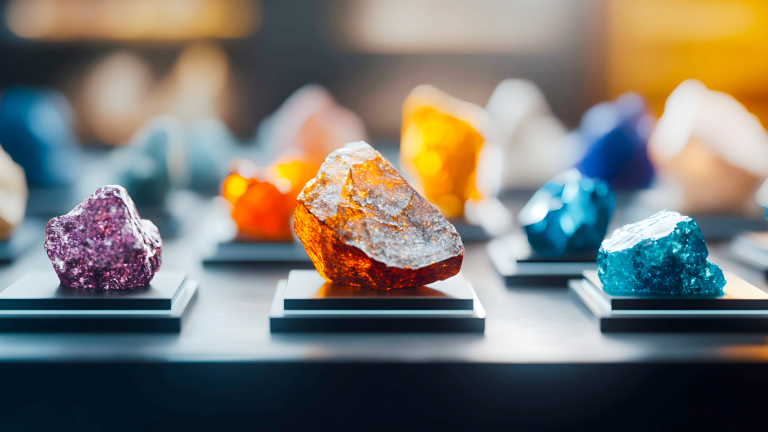Editor’s note: “Rare Earths: The ‘Picks and Shovels’ Powering a $20 Trillion AI Gold Rush” was previously published with the title “Rare Earth Metals and the Next High-Earning Big Tech Bottleneck” in August 2025. It has since been updated to include the most relevant information available.
Back in 1848, in Northern California, a worker helping to construct Sutter’s Mill made the discovery of a lifetime: There was gold in them there hills.
The news excited folks all around the country – and beyond – sparking a rapid mass migration to the American west, one of the largest in our nation’s history. It’s estimated that around 300,000 people moved to California between 1848 and ’55: the era that has since become known as the California Gold Rush.
Everyone who made the journey hoped to strike it rich with gold. Though in reality, very few miners found success – just about 1 in 100. Most either barely broke even or lost money on the whole endeavor.
But some folks took a different approach; one that would prove to be much more lucrative.
The people who became the wealthiest of the Gold Rush era were storekeepers, hoteliers, and suppliers of tools, clothing, food, and alcohol.
Take Levi Strauss – a name that’s surely familiar. He ‘struck it rich’ selling durable denim pants to miners: a venture so successful, it still exists today.
This idea of being the one who sells ‘the picks and shovels’ became a business proverb of sorts. And it certainly still applies today.
The Foundational Plays Inside the Robotics Revolution
In every revolution, the real winners are often the foundational suppliers.
- In the PC boom, microprocessor supplier Intel (INTC) and software supplier Microsoft (MSFT) surged immensely. Between 1986 and ‘99, MSFT stock saw ~97,000% returns…
- In the EV boom, lithium miners and battery makers crushed it. Battery maker Contemporary Amperex Technology Co., listed in China, became the world’s largest EV battery manufacturer, with its market cap rising more than 2,500% from 2018 to 2021.
- In the AI software boom, chip supplier Nvidia (NVDA) hit unprecedented highs, recently becoming the first publicly traded company to reach a market capitalization of $4 trillion.
Now comes the ‘next frontier’: a robotics revolution.
And the real picks and shovels there? Not just chips, silicon, or actuators – but rare earth metals and the magnets that need them.
Why Every Robot Needs Rare Earth Magnets – And Why That’s a Big Deal for Investors
The AI Boom is no longer just about data centers and chatbots. This tech is going physical.
That means the rise of real-world, embodied intelligence – robotics.
And it’ll encompass more than warehouse arms or autonomous vacuums. We’re talking about humanoid robots: machines that can walk, grasp, lift – think – potentially replacing human labor across factories, retail, elder care, logistics, and beyond over time.
It’s likely the next trillion-dollar transformation.
And as with every industrial revolution before it, this one will be built on a foundation of critical materials.
For example, humanoid robots like Tesla‘s (TSLA) Optimus are powered by a complex network of small, powerful electric motors in their shoulders, elbows, wrists, fingers, hips, knees, ankles, and toes. Each needs to be lightweight, high-torque, and ultra-efficient.
And the key ingredient inside all of them? Rare earth metals – specifically, neodymium-iron-boron (NdFeB) magnets.
These magnets deliver exceptional strength in a compact form. That’s critical for a battery-powered robot that needs to be agile and run for hours.
Nearly every actuator in Optimus (and its competitors) requires one. That means each humanoid robot could contain 2 to 4 kilograms of rare earth magnets – sometimes more than an EV.
And to make them, you need rare earth elements like neodymium, praseodymium, dysprosium, and terbium.
So, when it comes to the robotics boom:
- More robots → more motors
- More motors → more rare earth magnets
- More magnets → massive new demand for rare earth materials
This is physical AI’s supply chain, and it starts in the dirt.
China’s Rare Earth Monopoly Is America’s Current Industrial Challenge
Now, there’s just one problem: China currently controls over 85% of the world’s rare earth refining and magnet production.
That’s not ideal, especially considering that robots are likely to become a critical piece of the AI arms race between China and the United States. If tensions escalate, China could easily throttle magnet exports, as it has done before with rare earths.
Indeed, Tesla has already faced multi-week delays due to Chinese export license issues. That’s a preview of how vulnerable the U.S. robotics and AI ecosystem is to supply chain disruption.
And that’s why the U.S. is now scrambling to build a domestic rare earth supply chain.
Our country is investing billions of dollars in mining, refining, and magnet-making projects in the U.S., supported by Defense Production Act funding, DOE grants, and tariff protection.
MP Materials: America’s Most Strategic Rare Earth Stock Right Now
In fact, just days ago, the Pentagon announced a $400 million investment into MP Materials (MP), “instantly positioning the company as a strategic national security play – and sending its stock soaring 48% before the market even opened,” as InvestorPlace’s Louis Navellier noted.
Why MP? Because it owns the Mountain Pass mine in California – the only active rare earth mine in North America.
It’s also building a vertically integrated supply chain that includes rare earth separation, metal making, and NdFeB magnet production. In addition to the DoD’s investment, MP has secured a $1 billion financing commitment from Wall Street giants JPMorgan & Chase Co. (JPM) and Goldman Sachs (GS) for its new magnet manufacturing facility: the “10X Facility.”
And the firm has already signed a magnet supply agreement with General Motors (GM) and has plans to produce thousands of tons of magnets per year.
With Tesla aiming to ramp Optimus production toward millions of units per year, demand for rare earth magnets could soon explode. A robot with 3 kg of magnets at 5 million units/year implies 15,000 metric tons of new magnet demand – more than the U.S. currently produces in total.
MP is positioned as the only scaled U.S. supplier that can help meet this surge. Though, it won’t be the only winner in this niche for long…
Because America is now racing to build out its rare earth industrial base.
Clearly, it sees the writing on the wall. Physical AI is emerging fast – and it’s time to get prepared for it.
Investing In the Ecosystem Powering a Multi-Trillion-Dollar Transformation
Today, we’re on the verge of a robotics explosion – one that could redefine labor, productivity, and the global economy faster than most expect.
Rare earth magnets are among the invisible enablers of this revolution, alongside critical parts like motors, sensors, actuators, power modules, etc. These are to robotics what GPUs are to AI: foundational, bottleneck components.
Right now, behind the scenes, a vast ecosystem of suppliers is gearing up to power this robotic future – one that Morgan Stanley (MS) thinks could be worth up to $30 trillion.
If you want to get your portfolio ready for the next leap in this megatrend, don’t get distracted by flashy AI applications or speculative meme plays.
The last great technology rush minted fortunes for those who owned the ‘picks and shovels.’ Physical AI is that rush today; and rare earth metals are the shovels. But the window to stake your claim is closing fast.
Don’t be the miner who shows up late. Be the supplier who cashes in first.
InvestorPlace’s Louis Navellier, Eric Fry, and I have mapped the companies powering this trillion-dollar shift in our ‘Day Zero Portfolio.’


